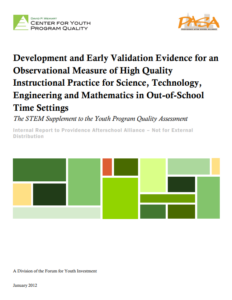Introduction
curricula from the fields of environmental science, technology, engineering, and mathematics (“STEM”) at 10 sites(one partner delivered the same curriculum at two sites). The offerings were organized at 10 school-based Afterzone sites and each offering included field work in the local Providence region. Across the 10 sites, STEM curricula were delivered to a total of approximately 250 middle school students (about 25 students per Afterzone section).
In order to evaluate the Afterzone Summer Scholars model and collect information for future improvement, PASA (a) hired an external evaluator for the project; (b) committed to providing continuous improvement supports to participating program managers and content providers (quality assessment and coaching); and (c) formed an evaluation advisory board to monitor the development and implementation of the external evaluation. In addition, PASA contracted with the David P. Weikart Center for Youth Program Quality (Weikart Center) at the Forum for Youth Investment to develop an observation-based measure of instructional practices to support continuous improvement during STEM programming. This report describes the process of development of the STEM supplement to the Youth Program Quality Assessment (Youth PQA; HighScope, 2005) and preliminary reliability and validity evidence based on data collected during Afterzone Summer Scholars program.
Smith, C., Hallman, S., Hillaker, B., Sugar, S., McGovern, G., & Devaney, E. (2012). Development and early validation evidence for an observational measure of high quality instructional practice for science, technology, engineering and mathematics in out-of-school time settings: The STEM supplement to the Youth Program Quality Assessment (pp. 1–25). Ypsilanti, MI: The David P. Weikart Center for Youth Program Quality.
